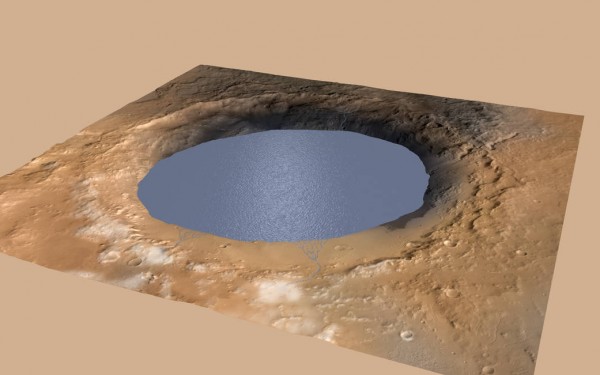By Ana Verayo, | February 07, 2017

This illustration depicts a lake of water partially filling Mars' Gale Crater, receiving runoff from snow melting on the crater's northern rim. (NASA/JPL-Caltech/ESA/DLR/FU Berlin/MSSS)
New data from NASA's Curiosity rover on Mars reveals evidence of carbon dioxide levels from 3.5 billion years ago. This crucial evidence indicates that these carbon levels were not sufficient enough to make the planet warm for water to become in liquid form.
In a new study, mission scientists analyzed minerals and sediments samples from the Gale Crater on Mars. NASA's Curiosity rover detected very low atmospheric levels coinciding with more than the last three billion years of the Red Planet's history. This new study challenges past studies which suggest that high atmospheric carbon levels or greenhouse gases were responsible for making water flow during the early history of Mars.
Like Us on Facebook
New findings show that carbon dioxide levels which used to exist on Mars was more than a hundred times lower for water to transform into liquid. Researchers from NASA's Ames Research Center say that since the surface of a young Mars was faintly heated by the sun, it is still a mystery how Mars sustained an active hydrological cycle without key carbon gases in the atmosphere.
Scientists now suggest two theories involving climate models and geological formations on Mars. One theory suggests a missing essential element that triggered this warming in the past and a second one speculates that ancient Martian lakes within the Gale crater were apparently not shaped by flowing liquid water.
During the Curiosity rover's exploration around Mount Sharp in the Gale Crater, it investigated a 70 meter wide layer of mudstone, siltstone and sandstone. Upon closer inspection, this provided crucial clues about a lake that existed in the region some 3.8 billion years ago.
Mission scientists say that carbonate compounds should be present on the surface of Mas due to high carbon dioxide levels billions of years ago and should leave remnants behind since greenhouse gases were supposed to be high to cause this kind of warming on Mars. To date, these carbonates remain elusive and undetected in significant amounts found in geological records.
This new study was published in the journal, Proceedings of the National Academy of Sciences
-
Use of Coronavirus Pandemic Drones Raises Privacy Concerns: Drones Spread Fear, Local Officials Say

-
Coronavirus Hampers The Delivery Of Lockheed Martin F-35 Stealth Fighters For 2020

-
Instagram Speeds Up Plans to Add Account Memorialization Feature Due to COVID-19 Deaths

-
NASA: Perseverance Plans to Bring 'Mars Rock' to Earth in 2031

-
600 Dead And 3,000 In The Hospital as Iranians Believed Drinking High-Concentrations of Alcohol Can Cure The Coronavirus

-
600 Dead And 3,000 In The Hospital as Iranians Believed Drinking High-Concentrations of Alcohol Can Cure The Coronavirus

-
COVID-19: Doctors, Nurses Use Virtual Reality to Learn New Skills in Treating Coronavirus Patients







